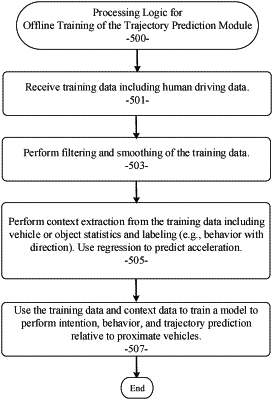| CPC G05D 1/0212 (2013.01) [G05D 1/0088 (2013.01); G08G 1/161 (2013.01); G08G 1/166 (2013.01); G08G 1/167 (2013.01); G05D 2201/0213 (2013.01)] | 20 Claims |

|
1. A system comprising:
a data processor; and
a prediction-based trajectory planning module, executable by the data processor, the prediction-based trajectory planning module being configured to:
receive perception data associated with a host vehicle;
extract host vehicle feature data and proximate vehicle context data from the perception data;
generate a proposed trajectory for the host vehicle;
use a trained trajectory prediction module to generate predicted trajectories for each of one or more proximate vehicles, the trained trajectory prediction module having been trained using training data comprising perception data and context data corresponding to human driving behaviors, the predicted trajectories for each of the one or more proximate vehicles corresponding to likely actions or reactions by each of the one or more proximate vehicles based on the human driving behavior context data if the host vehicle follows the proposed host vehicle trajectory; and
modify the proposed trajectory for the host vehicle if the proposed trajectory for the host vehicle will conflict with any of the predicted trajectories of the one or more proximate vehicles.
|